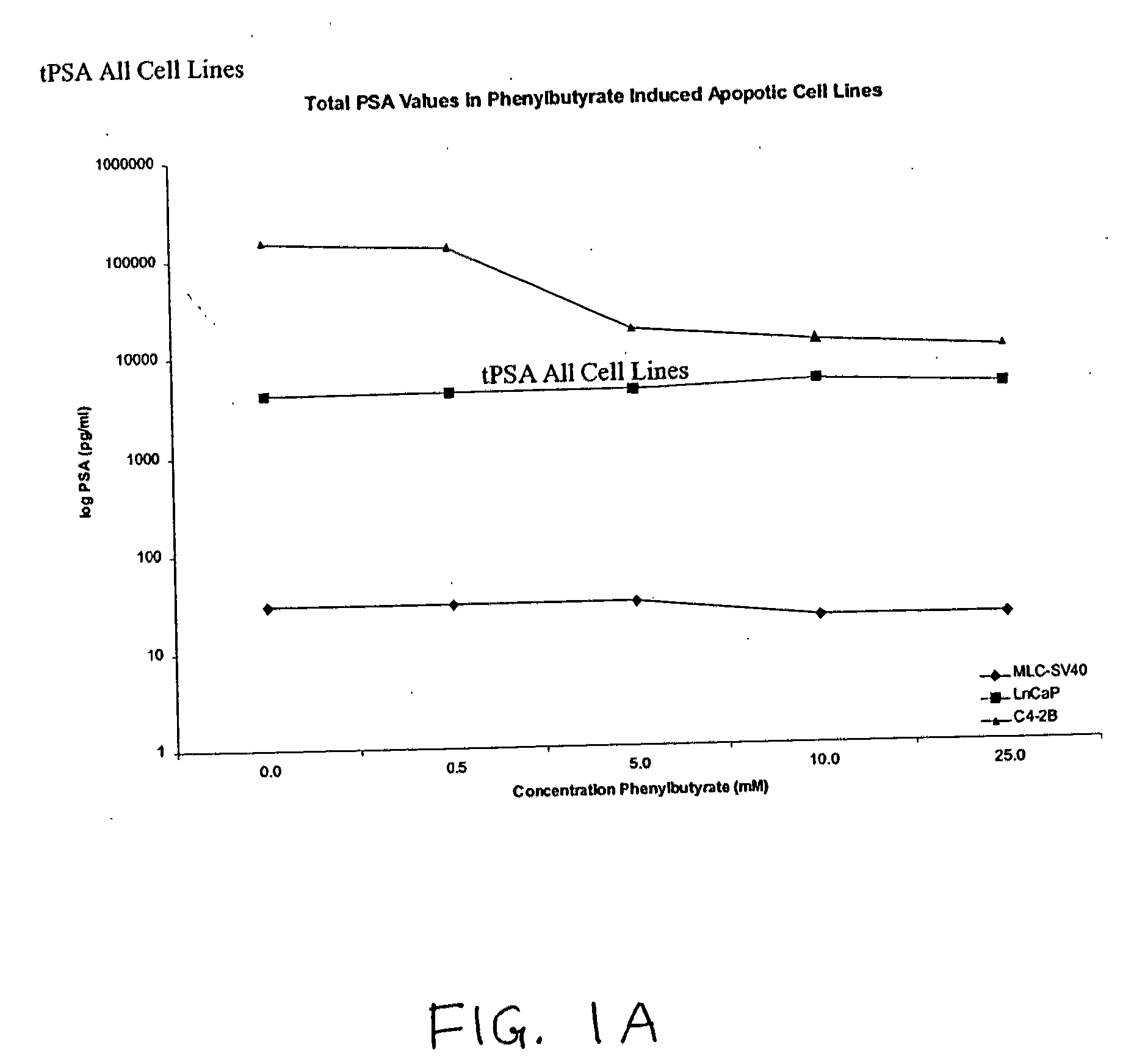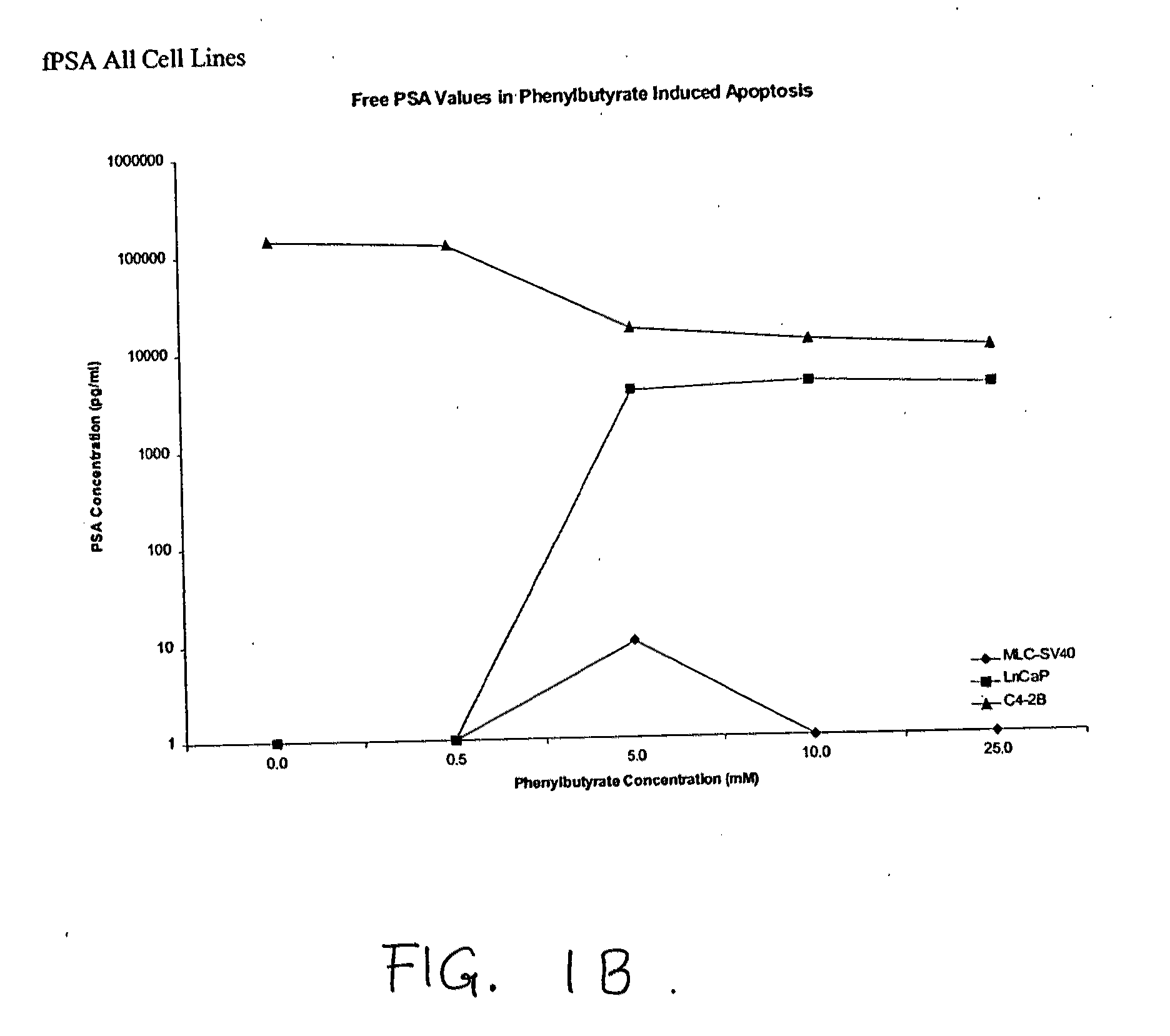New Molecular Target for Treatment of Cancer
a molecular target and cancer technology, applied in the field of cancer, can solve the problems of invading, abnormally fast growth of affected cells, and inability to distinguish between healthy and cancerous cells, and achieve the effect of increasing the expression of rna uc markers
- Summary
- Abstract
- Description
- Claims
- Application Information
AI Technical Summary
Benefits of technology
Problems solved by technology
Method used
Image
Examples
example 1
Materials and Methods
[0399]1. Cell Culture Methods
[0400]Cell lines, LNCap and C4-2B, were obtained from Dr. Leland Chung at the University of Texas MD Anderson Cancer Center (Thahnan et al., 1994)
[0401]Cell line MLC-SV40 was obtained from Dr. J.S. Rhim at National Cancer Institute.
[0402]LNCaP and C4-2B were cultured in T-Media, which is a combination of F-12 and DMEM. Vendor is Mediatech, Inc. 13884 Park Center Road, Herndon, Va. 20171 MLC-SV40 was cultured in Keratinocyte Serum Free Media with supplements. Vendor is Invitrogen Corp. 1600 Faraday Ave., P.O. Box 6482, Carlsbad, Calif. 92008.
[0403]Phenylbutyrate (4-Phenylbutyric Acid, Sodium Salt) was prepared at a 500 mM stock solution in PBS pH 7.2. Vendor is Triple Crown America, Inc. 13 N. 7th Street, Perkasie, Pa. 18944.
[0404]2. Monoclonal Antibodies
[0405]The following monoclonal and polyclonal antibodies were prepared to SEQ ID NO:3 and SEQ ID NO:4 as shown below:
UC28A Peptide (Amino Acids 54-74)
UC28A-1 Rabbit Polyclonal Antibod...
examples 2-7
Introduction to Examples 2-7
[0451]Three prostate cell lines were utilized to evaluate the effects of sodium phenylbutryate (SPB) treatment on induction of UC28 protein expression and apoptosis. The cell lines were MLC-SV40, a virally immortalized normal epithelial cell line, LNCaP, a malignant prostate epithelial cell line derived from the lymph node of a patient with prostate cancer, and the C 4-2B variant of LNCaP, which is a bone metastatic variant of the LNCaP parent epithelial cell line (Ng et al., 1997). SPB has been employed in clinical trials to treat cancer based upon its cellular differentiating and cell growth inhibitory activities (Ng et al., 2000). SPB has also been specifically applied to the treatment of prostate cancer patients (Carducci M A et al., 1996).
[0452]The UC28 gene was discovered using arbitrarily primed RNA fingerprinting methodology to human normal benign and cancer tissues (U.S. Pat. No. 5,882,864) and subsequently cloned (U.S. Pat. No. 6,171,796). Highl...
example 2
Effect of SPB on UC28 Gene Expression
[0453]The experiment was conducted to determine the impact of SPB on UC28 gene expression as well as its relationship to biochemical alterations of the apoptosis pathway in vitro. UC28 protein was localized on a membrane using rabbit polyclonal antibody produced against a UC28 synthetic peptide and visualized fluorescent confocal imaging technology. C4-2B is a sub-clone of the human LNCaP cell line developed in Dr. Leland Chung's laboratory (Thalmann et al., 1994), which is a bone metastatic cell line. The cells have been labeled with red fluorescent lipid-specific membrane stain (DiD, 1,1′-dioctadecyl-3,3,3′,3′-tetramethylindodicarbocyanine) and a green / yellow fluorescent labeled antibody directed at UC28 prostate gene-coded protein (An et al., 2000). It was found that a significant portion of the UC-28 protein localizes to the cell membrane of prostate cells.
PUM
| Property | Measurement | Unit |
|---|---|---|
| Volume | aaaaa | aaaaa |
| Molar density | aaaaa | aaaaa |
| Molar density | aaaaa | aaaaa |
Abstract
Description
Claims
Application Information
 Login to View More
Login to View More - R&D
- Intellectual Property
- Life Sciences
- Materials
- Tech Scout
- Unparalleled Data Quality
- Higher Quality Content
- 60% Fewer Hallucinations
Browse by: Latest US Patents, China's latest patents, Technical Efficacy Thesaurus, Application Domain, Technology Topic, Popular Technical Reports.
© 2025 PatSnap. All rights reserved.Legal|Privacy policy|Modern Slavery Act Transparency Statement|Sitemap|About US| Contact US: help@patsnap.com



